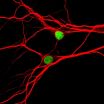New data suggest treatment effect on cognition leads to the treatment effect on function in patients
Study results published in the December issue of the Journal of Alzheimer's Disease
2014-12-03
(Press-News.org) INDIANAPOLIS, December 2, 2014 -- Today, Eli Lilly and Company announced results from new analyses of two Phase 3 trials evaluating the relationship between cognitive and functional treatment effects in patients with mild Alzheimer's disease. Based on post-hoc analyses of the Phase 3 trials, the findings suggested that cognitive deficits were more apparent than functional deficits in mild Alzheimer's disease when measured with the Alzheimer's disease Assessment Scale-Cognitive (ADAS-Cog) and the Alzheimer's disease Cooperative Study-Activities of Daily Living (ADCS-ADL) subscales. The apparent treatment effect on cognition based on these analyses led to the apparent treatment effect on function. These data were published in the December 2 issue of the Journal of Alzheimer's Disease.
"These data are important as they suggest that functional outcomes should be considered key secondary endpoints in a clinical trial of patients with mild Alzheimer's disease dementia, and they are consistent with the idea that Alzheimer's disease is primarily a disease of cognition and the functional deficits are mostly a consequence of these cognitive deficits," said Hong Liu-Seifert, Ph.D., study research advisor at Eli Lilly and Company. "We believe cognition and function are important to patients and caregivers and these data suggest that cognitive treatment effect drives functional treatment effect and can be considered a leading indicator for functional effect in patients with mild Alzheimer's disease."
Using pooled data from the solanezumab Phase 3 EXPEDITION and EXPEDITION2 trials, these post-hoc path analyses investigated the origins of the effects of solanezumab on cognition and function. This analysis showed that the effect on function was largely driven by effects of treatment on cognition (87 percent), with a relatively small portion (13 percent) due to a direct effect of solanezumab or through aspects of cognition not measured by the ADAS-Cog14.1 When the analysis was reversed, the effect on cognition was primarily due to a direct effect of solanezumab or through indirect effects not measured by the instrumental ADL (ADCS-iADL) (67 percent) with a smaller portion (33 percent) driven by an effect on function.1
Further, normalized ADAS-Cog and ADCS-ADL subscales showed cognitive impairment was more evident than functional impairment in mild Alzheimer's disease.1 The correlation between cognition and function increased over time.1 Results also showed that the iADL subscale showed greater impairment compared to the basic ADL (bADL) subscale, consistent with previous findings that iADL impairment precedes bADL impairment in the course of Alzheimer's disease progression. The results also suggest that iADL measures can be more sensitive than bADL measures in mild Alzheimer's disease patients.1 Similar patterns were observed regarding the apparent treatment difference of solanezumab versus placebo, with effect on ADAS-Cog being the greatest, followed by effect on iADL and bADL with the lowest impairment score.1 The outcomes of these analyses are consistent with findings from previous studies, which showed that cognitive deficits predict subsequent functional deficits and suggest that slowing cognitive decline may lead to slowing decline in function.
INFORMATION:
Analysis Methods1
Data from patients with mild Alzheimer's disease were pooled from two multicenter, double-blind, Phase 3 studies (EXPEDITION and EXPEDITION2), which were identical in design. Patients were randomized to infusions of 400-mg solanezumab (n = 654), or placebo (n = 660) every four weeks for 18 months. Cognitive and functional outcome measures were assessed using the ADAS-Cog and the ADCS-ADL, respectively. Post-hoc analyses included comparisons among normalized scales, correlations between outcome measures, and path analyses to model the relationship of treatment effect on cognition and function.
ELSE PRESS RELEASES FROM THIS DATE:
2014-12-03
Amsterdam, The Netherlands, December 2, 2014 - Detection, prevention, and preclinical treatment are three key areas that may make a difference in the battle to reduce the rapid rise of new Alzheimer's disease (AD) cases every year. These three topics are the focus of an important new supplement to the Journal of Alzheimer's Disease.
Organized by Guest Editor Jack de la Torre, MD, PhD, Professor of Neuropsychology at The University of Texas at Austin, the supplement is a novel guide to how Alzheimer dementia may be approached and managed right now, not years from now. ...
2014-12-03
Scientists have released details of a raft of new chemicals with potent anti-malarial properties which could open the way to new drugs to fight the disease.
A new paper in PNAS is the third published by the group at the Australian National University (ANU), which has collaborated with groups from around the globe to uncover potential ammunition in the fight against malaria.
Over 200 million people contract malaria each year, and the parasite that causes the disease has become resistant to most of the drugs currently available.
"The papers show the malaria parasite ...
2014-12-03
A glimmer of hope for corals as baby reef builders cope with acidifying oceans
While the threat of coral bleaching as a result of climate change poses a serious risk to the future of coral reefs worldwide, new research has found that some baby corals may be able to cope with the negative effects of ocean acidification.
Ocean acidification, which is a direct consequence of increased atmospheric carbon dioxide levels, is expected to have a deleterious effect on many marine species over the next century.
An international team examining the impact of ocean acidification ...
2014-12-03
Coral reefs provide a range of benefits, such as food, opportunities for income and education, but not everyone has the same access to them, according to a new study conducted by the ARC Centre of Excellence for Coral Reef Studies (Coral CoE) at James Cook University.
The researchers examined how people from 28 fishing communities in Madagascar, Kenya, Tanzania and Seychelles benefit from the marine environment.
For many years conservation in developing countries has been based on the assumption that improvements in ecosystem conditions, such as increasing coral reef ...
2014-12-03
December 3, 2014 -- Individuals conceived in the severe Dutch Famine, also called the Hunger Winter, may have adjusted to this horrendous period of World War II by making adaptations to how active their DNA is. Genes involved in growth and development were differentially regulated, according to researchers at the Leiden University Medical Center, Harvard University, and Columbia University's Mailman School of Public Health. Findings are published in the journal Nature Communications.
During the winter of 1944-1945 the Western part of The Netherlands was struck by a severe ...
2014-12-03
CHAPEL HILL, NC - UNC School of Medicine researchers have found for the first time a biochemical mechanism that could be a cause of "chemo brain" - the neurological side effects such as memory loss, confusion, difficulty thinking, and trouble concentrating that many cancer patients experience while on chemotherapy to treat tumors in other parts of the body.
The research, published in the Proceedings of the National Academy of Sciences, shows how the common chemotherapy drug topotecan can drastically suppress the expression of Topoisomerase-1, a gene that triggers the ...
2014-12-03
Coffee, apple juice, and vitamin C: things that people ingest every day are experimental material for chemist Eva-Maria Felix. The doctoral student in the research group of Professor Wolfgang Ensinger in the Department of Material Analysis is working on making nanotubes of gold. She precipitates the precious metal from an aqueous solution onto a pretreated film with many tiny channels. The metal on the walls of the channels adopts the shape of nanotubes; the film is then dissolved. The technique itself is not new, but Felix has modified it: "The chemicals that are usually ...
2014-12-03
WASHINGTON, D.C., December 3, 2014--A new report from the American Institute of Physics (AIP) Statistical Research Center has found that the number of Hispanic students receiving bachelor's degrees in the physical sciences and engineering has increased over the last decade or so, passing 10,000 degrees per year for the first time in 2012. The overall number of U.S. students receiving degrees in those fields also increased over the same time, but it increased faster among Hispanics.
From 2002 to 2012, the number of Hispanics earning bachelor's degrees in the physical sciences ...
2014-12-03
TALLAHASSEE, Fla. -- A team led by Florida State University researchers has identified DNA elements in maize that could affect the expression of hundreds or thousands of genes.
"Maybe they are part of the machinery that allows an organism to turn hundreds of genes off or on," said Associate Professor of Biological Science Hank Bass.
Bass and Carson Andorf, a doctoral student in computer science at Iowa State University, began this exploration of the maize genome sequence along with colleagues from FSU, Iowa State and the University of Florida. They wanted to know ...
2014-12-03
New York, NY, December 2, 2014 - Immediate breast reconstruction following mastectomy is becoming more prevalent. However, in breast cancer patients undergoing simultaneous chemotherapy, thrombotic complications can arise that can delay or significantly modify reconstructive plans. Outcomes of cases illustrating potential complications are published in the current issue of Annals of Medicine and Surgery.
Chemotherapy is increasingly used to treat larger operable or advanced breast cancer prior to surgery. Chemotherapy delivered via the placement of a central venous line ...
LAST 30 PRESS RELEASES:
[Press-News.org] New data suggest treatment effect on cognition leads to the treatment effect on function in patients
Study results published in the December issue of the Journal of Alzheimer's Disease




